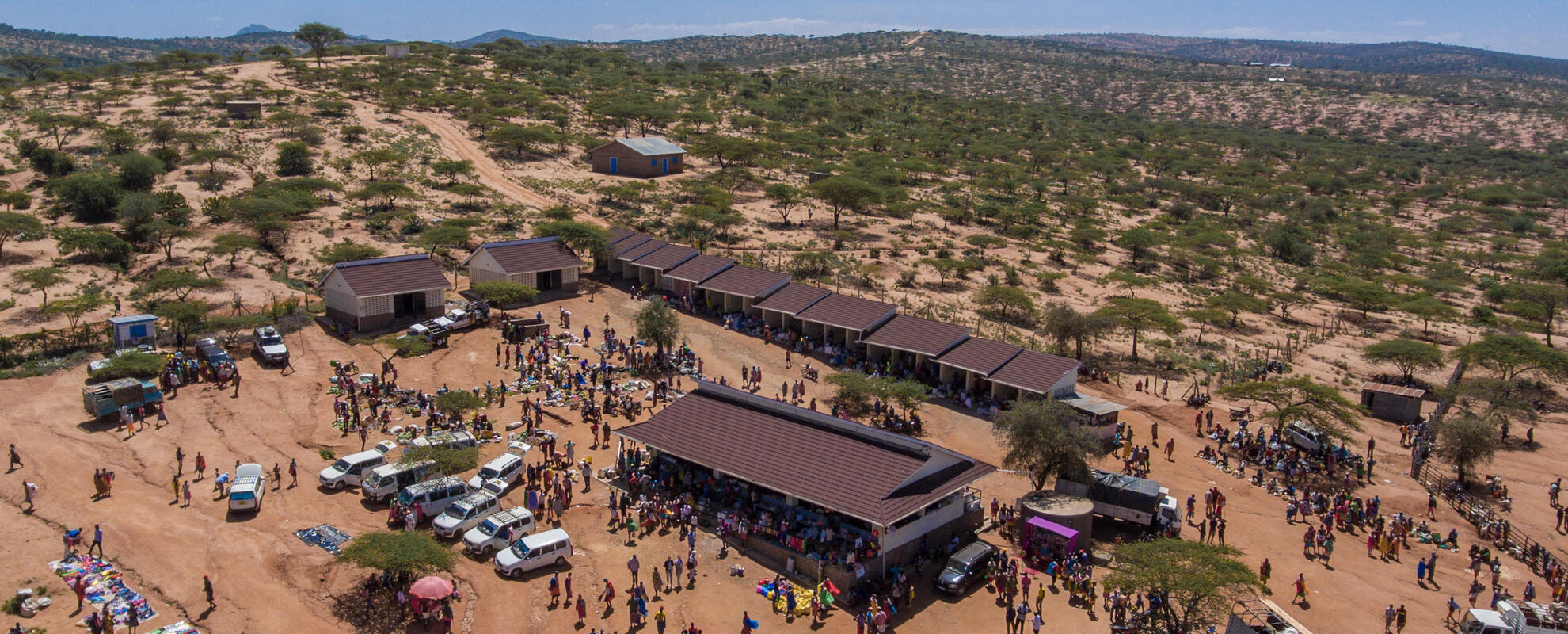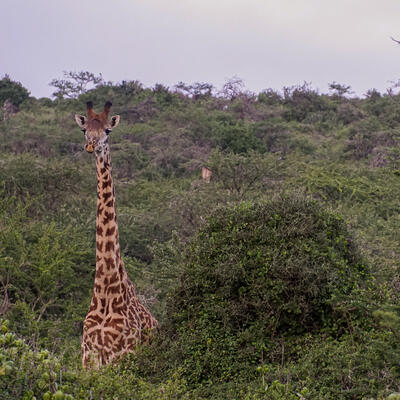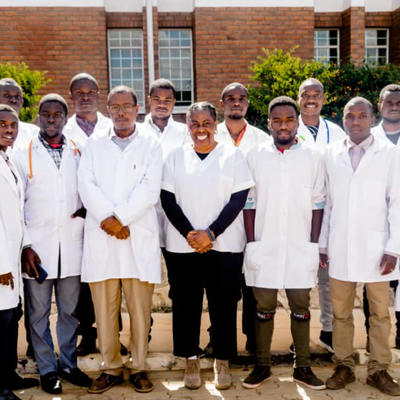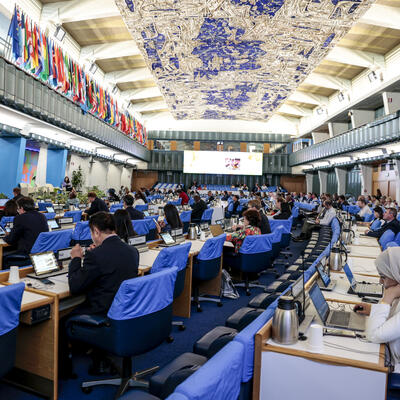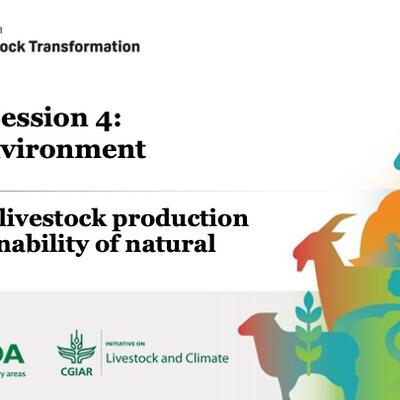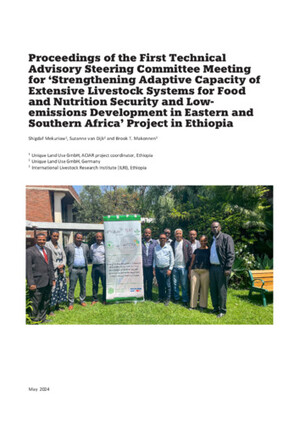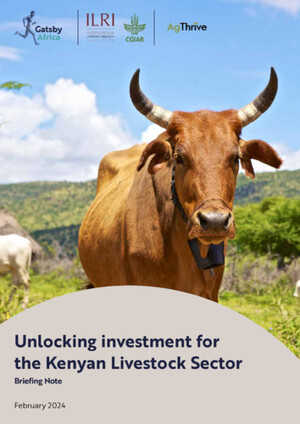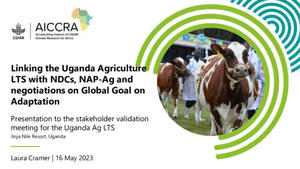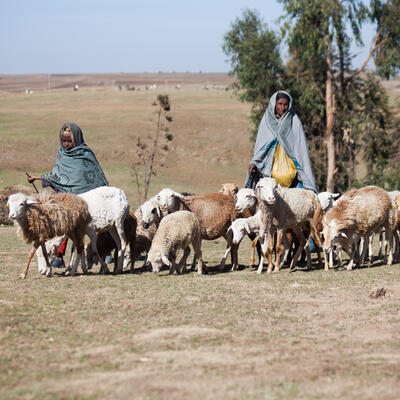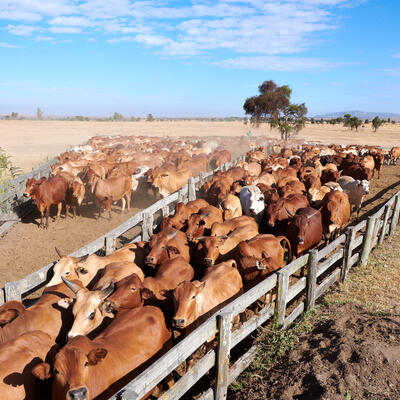
Using virtual communication tools to support northern Kenya partners during the COVID-19 pandemic
An aerial view of the Oldonyiro Livestock Market in Isiolo County (photo credit: USAID/Mwangi Kirubi).
Update from the livestock component of the AVCD program
Over the last three months (April – June), the livestock value chain (LVC) team of the Accelerated Value Chain Development (AVCD) program has worked tirelessly to maintain close and consistent communications with the county-based field office staff and the respective county government officials in Turkana, Garissa, Wajir, Isiolo and Marsabit.
The LVC team quickly adapted to the COVID-19-related uncertainty and movement restrictions by adopting web conferencing as a means of communication with the project staff and stakeholders. Through the increased use of virtual tools such as Zoom, Microsoft Teams, WhatsApp, and voice calls and phone messaging, the project has formed a think tank to monitor closely the implementation of project activities towards the set target despite the pandemic.
Under agri-nutrition messaging, LVC field coordinators, in close collaboration with county nutrition coordinators (CNCs) in the five target counties, initiated a process of updating county nutrition fact sheets, which were last updated in 2017. The nutrition fact sheet is a crucial advocacy and lobbying tool towards increasing budgetary allocation for nutrition-sensitive interventions and it provides a quick snapshot of the performance of essential nutrition indicators in the counties. In Turkana County, the fact sheet was completed in April and is awaiting approval. Road maps towards updating similar fact sheets and mass producing them are due to be finalized and completed in Garissa, Wajir, Marsabit and Isiolo counties before the end of July.
In Turkana County, different community units have formed WhatsApp groups comprising of the respective community health volunteers (CHVs) administered by their community health workers (CHWs). The field coordinator has liaised with the CHWs in mobilizing CHVs to send, through WhatsApp, the data they have collected during this period, to the monitoring and evaluation team for entry and updating of the AVCD monitoring platform, Me@sure. Also, to enhance public awareness on better nutrition during this period of interrupted food supply, especially of fruits and vegetables, the project has collaborated with the county nutrition teams in all the target counties to support mass dissemination of agri-nutrition messages that promote dietary diversity and alternative nutrient-dense food sources. Due to movement restrictions, the project is engaging local radio stations to develop agri-nutrition messaging as malnutrition remains a significant threat in the five counties.
Under the animal health and disease surveillance component, the project has worked with the County Department of Veterinary Services (CDVS) in Turkana, Isiolo, Wajir and Garissa to start the use of a closed user group (CUG); a platform developed by Safaricom Limited, to facilitate timely flow of e-surveillance livestock disease outbreaks information from the community disease reporters (CDRs) to county headquarters. Through Zoom virtual meetings, the project, in collaboration with Safaricom Limited, has held CUG sensitization meetings, which were attended by key county officials in the four counties. The CUG platform will significantly improve early warning and response to livestock diseases outbreaks and thereby support the LVC component to achieve its goal of enhancing resilience, food security, and economic growth in northern Kenya.
Initially, 100 members in each county were activated to use the CUG in communicating among themselves—the project is working closely with the CDVS to extend the CUG membership from 100 to about 500 individuals. Turkana County has already submitted its additional list of 400 members to Safaricom Limited for activation. This platform will increase data reporting across the county, allowing data-driven livestock disease response decisions. For example, in Wajir, the community disease reporters have been able to use the CUG platform to relay information about an outbreak of lumpy skin disease (LSD) in cattle in Bute Ward. The communication between the sub-county vets, CDRs, CDVS and ward participatory rangelands management (PRM) committee prompted vaccination campaign by the county veterinary services department to prevent a full-blown outbreak of LSD in the entire sub-county. The County Department of Veterinary Services quickly mobilized resources to mitigate the effects of the LSD, which would otherwise have resulted in substantial economic and food security impact on the affected population. A total of KES360,000 (approx. USD3,600) was raised and 6,000 cattle from 200 households were vaccinated. This quick response emanating from effective communication between the CDRs and sub-county vets facilitated by the use of CUG saved the county economy over USD 43,795,500.00, as shown in the table below.
| Cost | Number of cattle in Wajir North | Unit cost (KES) | Total cost (KES) | Total cost (USD) |
| Vaccination | 219,000 | 10 | 2,190,000 | 21,900.00 |
| Treatment cost by use of antibiotics (supportive treatment) | 219,000 | 6,000 | 1,314,000,000 | 13,140,000.00 |
| Mortality loses at 40% of the total cattle population | 80,760 | 26,000 | 2,099,760,000 | 20,997,600.00 |
| Weight loss at 10% of the body weight | 219,000 | 2,600 | 569,400,000 | 5,694,000.00 |
| Damage to hides at 60% morbidity | 131,400 | 3,000 | 394,200,000 | 3,942,000.00 |
| Total quantifiable cost | 4,379,550,000 | 43,795,500.00 |
In Turkana County where the use of the closed user group started earlier, communication among the members has been enhanced through video conferencing where sharing of experiences is taking place at no additional cost. Due to the introduction of the CUG platform, there has been a gradual increase in reporting livestock diseases symptoms by the CDRs to the sub-county vets. The graph below shows the gradual increase in the number of livestock disease cases between March and May. It is anticipated that more cases will be reported through the help of the CUG operation, and this will trigger a data-driven response by the CDVS.
 Turkana county report on livestock disease symptoms by month (credit: AVCD).
Turkana county report on livestock disease symptoms by month (credit: AVCD).
Under the sustainable rangelands management component, the project in collaboration with the Livestock Market Systems (LMS) Activity Award 2, started a WhatsApp group comprising of county and sub-county officials trained in participatory rangeland management (PRM), and the 33 ward planning committee members trained in Bute Ward in Wajir County. The WhatsApp group allows the project to share information with county and sub-county officials and offer guidance to the ward planning committee on how to implement their grazing plans effectively. Also, the created platform enables the sharing of information such as the monthly National Drought Management Authority bulletin on drought and vegetation coverage index and the weather forecast to allow the committee to adjust its plan to the seasonal patterns experienced in the county. Farther, the platform provides a medium through which AVCD LVC and LMS track progress in the implementation of PRM activities and provide technical backstopping to the teams on the ground.
Trained ward committees continue to monitor the spatial distribution of rains, the quantity of pasture and the availability of water in the wet season grazing area to help the participatory rangeland management committee make sound grazing management plans for the current season. The committee also monitors the flooding areas and advises the community accordingly. During the current COVID-19 pandemic, the trained ward planning committee members in Bute have been cascading the PRM training to a location level by organizing the location grazing committee in five locations of the ward namely Gumurey, Dugo, Adadjijole, Walensututu and Ogomdi. A total of 60 local grazing committee members were sensitized on the use of PRM toolkit. The locational committees will champion the implementation of the seasonal grazing plans that were developed with the support of AVCD-LC and LMS.
At the same time, AVCD LVC component recently completed a collection of quantitative data on the ‘Impact of COVID-19 on livestock value chain actors and food systems in arid areas of Kenya’ study. Data collection was done through cell phone interviews among selected value chain actors namely, producers, livestock traders, livestock transporters, livestock market associations, agro vets, community disease reporters, and traders of vegetables, fruits, cereals and pulses. The results from the study will provide critical information on the extent of damage to people’s livelihoods, community and institutional resilience mechanisms that need to be reinforced, and the recovery interventions that AVCD and other partners can introduce to respond and rejuvenate the local economy from the effects of the COVID-19. This study will help to structure, streamline, prioritize and guide any intervention towards the affected people. Results will also help build synergy and coordination among partners and the local governments towards supporting the affected communities.





